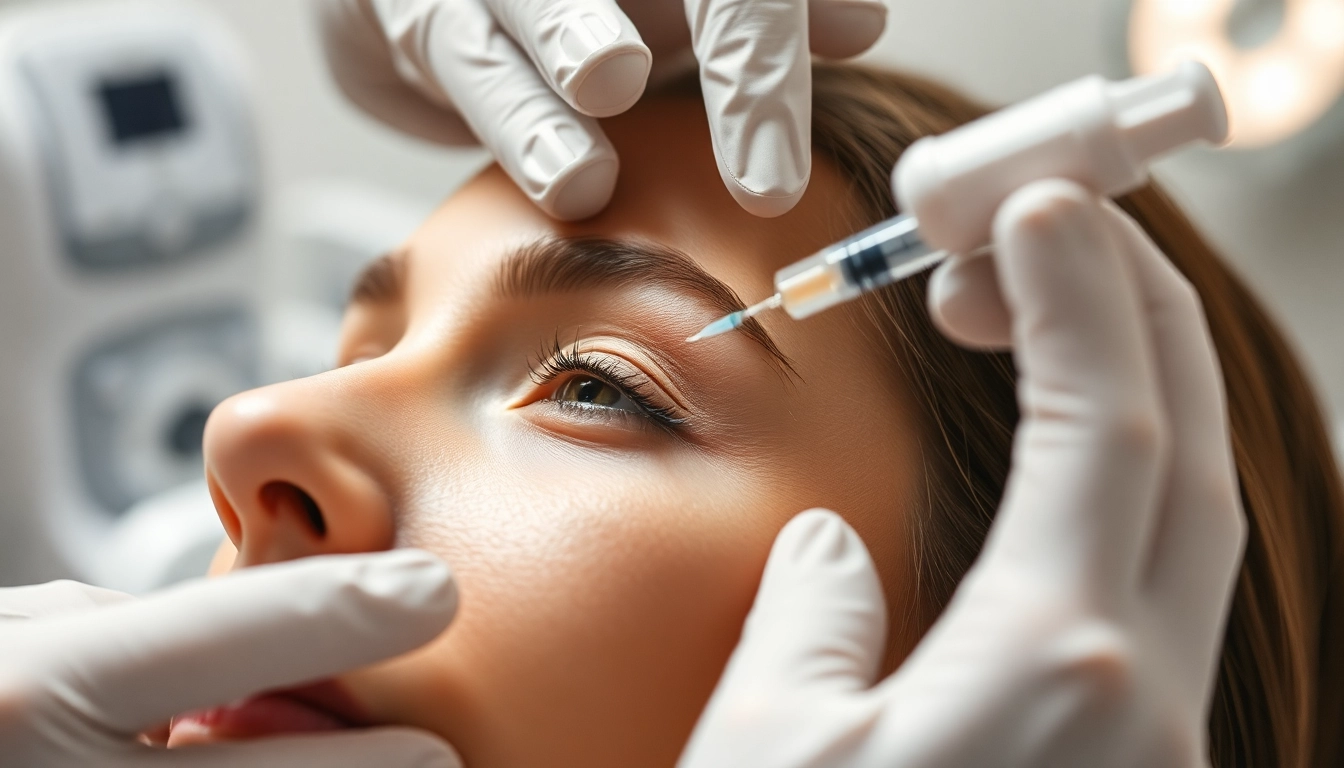Understanding Botox Behandlung
Botox Behandlung has become a go-to solution for individuals seeking aesthetic enhancements. This treatment has been extensively discussed in medical literature, and its popularity continues to rise. By examining the intricacies of Botox, its history, and its diverse applications, one can appreciate its benefits beyond mere cosmetic purposes. For those interested, detailed information about the Botox Behandlung process is essential for informed decisions.
What is Botox and How Does it Work?
Botox, or botulinum toxin type A, is a neurotoxic protein produced by the bacterium Clostridium botulinum. It functions by blocking the release of acetylcholine, a neurotransmitter responsible for muscle contraction. When injected into specific facial muscles, Botox induces temporary paralysis, resulting in a smoothing effect on wrinkles.
The primary mechanism by which Botox operates involves the disruption of the communication between nerves and muscles. The result? A significant reduction in the appearance of dynamic wrinkles, which are caused by repetitive facial expressions such as frowning, smiling, and squinting.
History and Development of Botox Treatments
The use of Botox dates back to the 1980s when it was first approved for medical applications. Originally, it was utilized to treat eye disorders, notably strabismus and blepharospasm. Over the years, evidence supported its efficacy in treating various conditions, leading to its approval for aesthetic use in the late 1990s. This timing coincided with a growing public interest in non-surgical cosmetic enhancements.
The FDA’s approval of Botox for cosmetic use paved the way for its widespread adoption in the beauty industry. As techniques evolved and practitioners became more adept at using Botox, demand skyrocketed, transforming it into one of the most popular treatments worldwide.
Current Applications Beyond Aesthetics
While Botox is predominantly known for its facial aesthetic benefits, it has a plethora of medical applications. These include treatment for chronic migraines, excessive sweating (hyperhidrosis), and even muscle spasticity related to neurological disorders. This versatility has established Botox as a multifaceted therapeutic agent in modern medicine.
One notable application is its use in treating chronic migraines. Studies have shown that patients who receive Botox injections in specific head and neck locations experience a reduction in the frequency and severity of migraine attacks. Similarly, for those suffering from hyperhidrosis, Botox can effectively reduce sweating by blocking the nerves that stimulate sweat glands.
Benefits of Botox Behandlung
Smoothing Fine Lines and Wrinkles
The most common reason individuals seek Botox treatments is to smooth fine lines and wrinkles. Unlike traditional facelifts, which require surgical intervention, Botox offers a minimally invasive alternative that delivers quick results. Most patients can see the effects of treatment within a few days, with results lasting three to six months.
Areas commonly treated with Botox include the forehead, crow’s feet (around the eyes), and frown lines (between the eyebrows). Each of these regions warrants a specific treatment approach based on patient anatomy and desired outcomes.
Medical Uses of Botox Beyond Cosmetics
As previously mentioned, Botox’s utility extends to various medical conditions. For instance, individuals suffering from overactive bladder can find relief through Botox treatment, which can decrease urinary incontinence by relaxing the bladder muscles. Additionally, Botox has shown promise in alleviating symptoms of chronic migraines, providing patients an alternative to daily medications.
Furthermore, Botox has been proven beneficial for those dealing with temporomandibular joint disorders (TMJ), where injections can reduce muscle tension and alleviate pain. This underscores the broad application of Botox, positioning it as not just a cosmetic solution but a comprehensive therapeutic option.
Safety and Effectiveness of Botox Treatments
One of the most pressing concerns for individuals considering Botox treatment is its safety. Research indicates that Botox is generally safe when administered by a qualified practitioner. Serious side effects are rare, with temporary bruising and localized pain at the injection site being the most common complaints.
Efficacy studies demonstrate that Botox consistently reduces the visibility of wrinkles and treats various medical conditions effectively. Regular follow-ups and personalized treatment plans can optimize results and ensure patient safety.
Cost and Factors Influencing Botox Behandlung Prices
Average Costs for Botox Treatments
The cost of Botox treatment varies widely based on geographic location, provider expertise, and the area being treated. On average, prices can range from $300 to $600 per session. It’s important to note that the cost is often calculated based on units of Botox used, with one unit typically costing $10 to $20.
Patients should be informed that while the price may seem high, considering the duration of effects and the convenience of a non-surgical procedure, many find value in the investment.
What Affects the Cost of Treatment?
Several factors influence the overall cost of Botox treatments:
- Practitioner Expertise: Highly experienced practitioners may charge more for their services, but this can often translate into superior results and a lower risk of complications.
- Location: Urban areas or regions with high living costs typically see higher treatment prices.
- Number of units needed: The total amount of Botox required for desired results significantly impacts the final price.
- Facility fees: Costs may vary depending on whether the treatment is performed in a medical spa, clinic, or hospital.
Insurance Coverage Considerations
Most cosmetic Botox procedures are not covered by insurance, as they are deemed elective. However, for medically necessary treatments—such as those for chronic migraines or excessive sweating—some insurance policies may provide partial or full coverage.
Patients should check with their insurance provider and discuss their specific situation with their healthcare professional to understand what coverage options are available.
Preparing for Your Botox Behandlung
Consultation: What to Expect
The initial consultation is a vital step in the Botox experience. Patients should expect a thorough discussion about their medical history, concerns, and treatment goals. Qualified practitioners will assess the patient’s facial anatomy and discuss realistic outcomes.
This step is also the opportune moment for patients to ask questions regarding the procedure, potential side effects, and aftercare. Clarity and understanding foster trust, ensuring a positive treatment experience.
Pre-Treatment Guidelines and Precautions
Preparing for Botox treatment involves adhering to specific pre-treatment guidelines to optimize results and minimize risks. Patients are typically advised to:
- Avoid blood-thinning medications and supplements (e.g., aspirin, ibuprofen, vitamin E) for at least a week before treatment.
- Refrain from alcohol consumption in the days leading up to the procedure.
- Consult with the practitioner if pregnant or nursing.
Following these guidelines can help reduce the risk of bruising and enhance the overall effectiveness of the treatment.
Post-Treatment Care for Optimal Results
Effective post-treatment care is essential to achieving the desired results from Botox injections. Patients should follow these post-care tips:
- Avoid lying down for at least four hours post-treatment to prevent the migration of the toxin.
- Steer clear of strenuous exercise for 24 hours to minimize swelling.
- Refrain from applying pressure to the treated areas, including facial massages or facials, for a few days.
These guidelines help ensure that the Botox settles appropriately and that patients enjoy optimal results from their treatment.
Exploring Results and Patient Experiences
Before and After: Real Patient Transformations
The transformative power of Botox is illustrated through numerous patient experiences. Before and after photographs reveal striking improvements in aesthetics, showing significant reductions in wrinkle visibility. Many patients report an increase in self-confidence following their treatments due to enhanced facial symmetry and smoother skin.
Success stories often highlight how non-invasive procedures can lead to profound psychological and emotional benefits. Those who experienced life-altering changes often share their journeys through testimonials and online forums, creating a valuable resource for potential patients.
Potential Side Effects and How to Manage Them
While Botox is generally safe, some patients may encounter side effects, albeit usually mild. Common side effects include bruising, swelling, and temporary headaches. In rare cases, patients might experience more severe side effects, such as drooping eyelids or undesired facial asymmetry.
Should any severe side effects occur, it’s crucial for patients to contact their healthcare professional immediately. Early intervention can mitigate potential complications and ensure a safe recovery.
Long-lasting Results and Follow-Up Treatments
The results of Botox treatments typically last between three to six months, depending on various factors, including individual metabolism and the location of injections. To maintain the desired aesthetic effects, patients are encouraged to schedule follow-up treatments before the effects completely wear off.
Many practitioners recommend a tailored treatment plan that adapts to the patient’s changing aesthetic goals and the results of previous treatments. This approach ensures lasting beauty and satisfaction over the long term.



